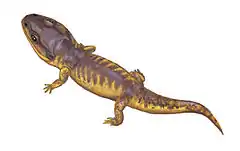Arcadia Formation, Australia
The Arcadia Formation is a geological formation located within central-eastern Queensland, Australia, which has been aged between the Induan–Olenekian epoch of the Early-Triassic period. It is most well known for its abundance of Early-Triassic aged fossils, most notably its high diversity of amphibians.[1][2]
| Arcadia Formation | |
|---|---|
| Stratigraphic range: Induan-Olenekian ~ | |
| Type | Geological formation |
| Unit of | Rewan Group |
| Underlies | Brumby Sandstone Member |
| Overlies | unconformity with Glenidal Formation conformity Sagittarius Sandstone |
| Thickness | Up to 500 m (1,600 ft) |
| Lithology | |
| Primary | Red mudstone, siltstone, fine-grained sandstone |
| Location | |
| Coordinates | 24.8°S 148.0°E |
| Approximate paleocoordinates | 58.0°S 136.0°E |
| Region | |
| Country | |
| Extent | Bowen Basin |
| Type section | |
| Year defined | 1988 |
 Arcadia Formation, Australia (Australia)  Arcadia Formation, Australia (Queensland) | |
Description
The Arcadia Formation is a sequence of sandstones and mudstones deposited as a result of freshwater rivers and lakes during the Induan–Olenekian epoch.[3] The Arcadia Formation represents one of the oldest known Mesozoic formations within the entirety of Australia, as well as containing relatively well-preserved specimens for its age and country. At the time at which the Arcadia Formation was building up, the then region of today's Australia was still recovering from the recent Permian–Triassic extinction event which had resulted in the global biodiversity remaining at a low level throughout much of the lower Triassic.[4] The world currently was generally a hot and arid environment reaching an average temperature of more than 80o S. This is suggested by the red color of sediments found within the Bowen Basin.
The fauna and flora from the formation are not abruptly unique in comparison to the known fauna or flora from the rest of the world at this time, however the Arcadia Formation has an unusually high diversity of amphibians, with 90% of the fauna from the Arcadia Formation being made up of amphibians. So far, the formation's fauna is known to consist of brachiopods, fish, amphibians, reptiles and synapsids. There is also a high diversity of ichnotaxa based on coprolites.[5]
Vertebrate paleofauna
Fish
| Fish | ||||
|---|---|---|---|---|
| Genus | Species | Material | Notes | Images |
| Aphelodus | A. anapes | A single tooth[6] | An sagenodontid | |
| Namatozodia | N. pitikanta | An incomplete skull | An gnathorhizid | |
| Ptychoceratodus | P. phillipsi | An sagenodontid |  | |
| Saurichthys | S.giga | Partial skull | ||
Amphibians
| Amphibians | ||||
|---|---|---|---|---|
| Genus / Taxon | Species | Material | Notes | Images |
| Acerastea | A. wadeae | Partial skeleton | A rhytidosteid | |
| Arcadia | A. myriadens | Partial skeleton | A rhytidosteid |  |
| Keratobrachyops | K. australis | Partial skull | A trematosaurian | |
| Lapillopsis | L. nana | Two nearly complete skulls. | A stereospondyl |  |
| Nanolania | N. anatopretia | A partial skull | A rhytidosteid |  |
| Plagiobatrachus | P. australis | A set of vertebrae | A plagiosaurid | |
| Rewana | R. quadricuneata | Incomplete skull and partial postcranial skeleton | A stereospondyl | |
| Tirraturhinus | T. smisseni | Partial section of the skull | A trematosaurian | |
| Warrenisuchus | W. aliciae | An incomplete skeleton | A capitosaurid | |
| Watsonisuchus | W. gunganj & W. rewanensis | Both known from incomplete skulls | A capitosaurid | |
| Xenobrachyops | X. allos | A partial skull | A brachyopid | |
| Trematosauridae | Indeterminate | Partial rostrum | A brachyopid | |
Reptiles
| Reptiles | ||||
|---|---|---|---|---|
| Genus / Taxon | Species | Material | Notes | Images |
| Eomurruna | E. yurrgensis | More than 40 referred specimens, including partial skeletons | Australia's so far only reported procolophonoid | |
| Kadimakara | K. australiensis | Partial skull, including the rear part of the skull and a fragment of the jaw | An early archosauromorph similar to Prolacerta |  |
| Kalisuchus | K. rewanensis | Holotype consists of partial left maxilla | A basal archosauriform |  |
| Kudnu | K. mackinlayi | Partial skull including anterior of cranium and both dentaries | An lepidosauromorph | |
Synapsids
| Synapsids | ||||
|---|---|---|---|---|
| Genus / Taxon | Species | Material | Notes | Images |
| Dicynodontia | Indeterminate | A quadrate, part of a tusk & a partial femur | Some of the only dicynodont remains known from Australia | |
References
- "(Rewan Formation) (Triassic of Australia)". FossilWorks.
- "Stratigraphic Unit Details Arcadia Formation". Australian Stratigraphic Units Database.
- "Arcadia Formation". Australia: The Land Where Time Began.
- Sahney, S.; Benton, M.J. (2008). "Recovery from the most profound mass extinction of all time". Proceedings of the Royal Society B: Biological Sciences. 275 (1636): 759–65. doi:10.1098/rspb.2007.1370. PMC 2596898. PMID 18198148.
- Caroline, Northwood (2005). "Early Triassic coprolites from Australia and their palaeobiological significance". The Journal of the Palaeontological Association. doi:10.1080/02724634.2011.595858. S2CID 140599970.
- "Aphelodus anapes". Retrieved 17 December 2021.